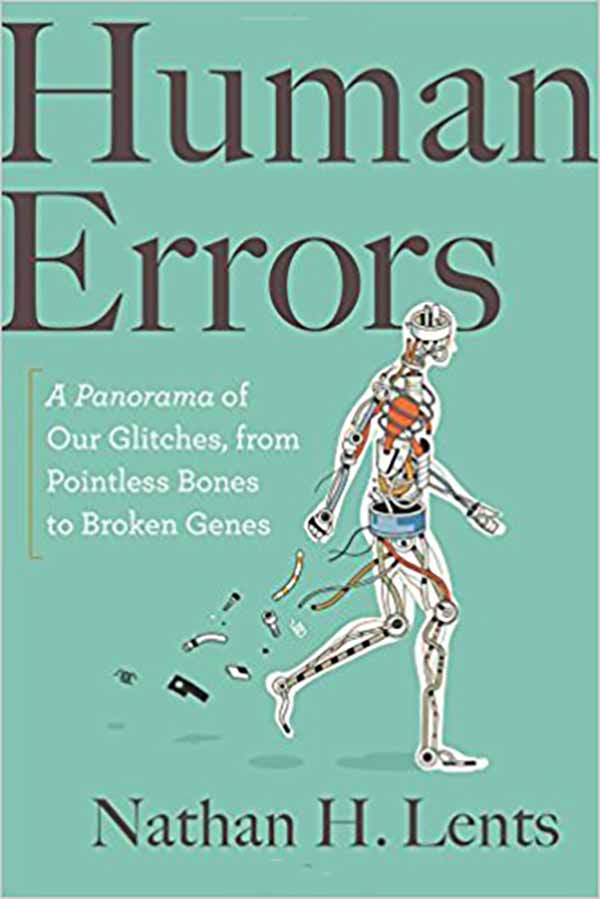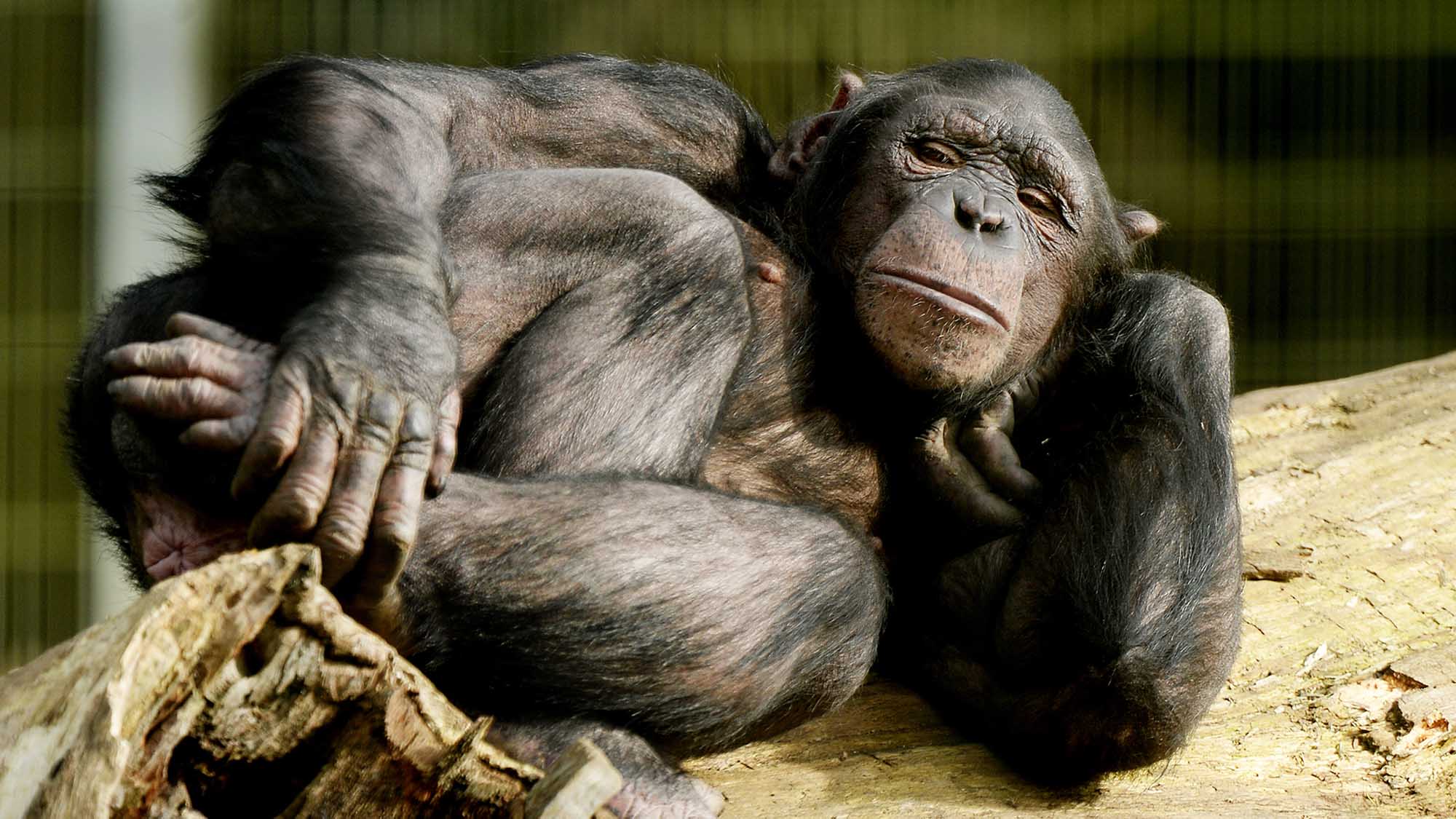Evolution is a work in progress, so it’s hardly surprising that some of the features it has built into the human body are still far from optimal. And of all those features, one of the hardest to explain is also one of the most conspicuous: external testicles.

From an evolutionary standpoint, after all, testicles are the most important thing about a man — without them, he wouldn’t exist at all. And there they are, just sitting out in the open. Exposed. Vulnerable. What kind of design is this?
Of course, there is an explanation. Human sperm cells develop better at a slightly lower temperature than the rest of our body seems to prefer. Humans aren’t alone in this respect: Most male mammals have testicles that migrate through the inguinal canal during gestation or infancy and eventually take up residence outside the abdominal cavity, suspended in a temperature-sensitive adjustable hammock. This allows the sperm cells to develop at the temperature that’s just right.
But is it really just right? Only if you accept that the ideal temperature is a special fixed property of the universe, like Planck’s constant or the speed of light in a vacuum. Evolution could have simply tweaked the parameters of sperm development so the ideal temperature of its enzymatic and cellular processes was the same as the rest of the body’s processes. Hematopoiesis, the creation of new blood cells, is a close parallel of sperm development in terms of the tissue architecture and cellular events involved, yet bone marrow doesn’t grow outside our body. Nor do ovaries, for that matter.
The fact is that there is no good reason that sperm development has to work best at lower temperatures. It’s just a fluke, an example of poor design. If nature had an intelligent designer, he or she would have a lot to answer for. But since natural selection and other evolutionary forces are the true designers of our bodies, there is no one to question about this. We must interrogate ourselves: Why are we like this?
The so-called “argument from poor design” goes back to Darwin himself. Prior to evolutionary theory, most people, scientists included, considered the world and everything in it to be the flawless creation of a perfect God. Of course, the rampant imperfections we can all easily spot called out for explanation and usually invoked a response along the lines of a “fall from grace” or some other such hand-waving. Now that we know that evolution is the creative force of life, we can be free from the expectation of perfection.
But we’re not. Far too often we repeat refrains like “Well, it must do something important or natural selection would have eliminated it,” or “Living things are perfectly suited for their habitats,” or “Evolution doesn’t tolerate inefficiency.” We haven’t really moved on from the creationist mindset that expects to see perfection in nature.
The reality is that evolution is aimless, natural selection is clumsy, and there’s no such thing as being perfectly adapted. Our bodies are a mishmash of compromises forged in different eras and by survival forces very different from the ones we now face. Evolution can work only with the bodies that we have, as they are, and can achieve “progress” only through the slightest tweaks and tugs. Even more frustrating, the selective forces themselves are constantly changing due to the dynamic nature of environments and ecosystems.

External testicles are just such an example. There are competing theories on how this strange quirk came about. Perhaps the testicles were escaping the newly warming abdomen of early mammals. There are other, more esoteric hypotheses as well, none of them perfectly satisfying, all of them potentially contributing a kernel of truth. In the end, it doesn’t really make sense, but, well, there they are.
In addition to the obvious danger of designing such important organs without any protection or even padding, external testicles introduce additional problems for mammals. One in four men will develop a hernia in their groin, 10 times the rate of women, precisely because of a weakness in the abdominal wall left from the migration of the testicles out of the abdomen. Surgical repair is relatively straightforward, but surgery is a relatively new invention in the history of our species. While only a small percentage of these hernias become life-threatening, given how common they are, hernias have killed untold millions over the ages.
The interesting evolutionary questions don’t end with the origin of external testicles. How they got there is one question; what has happened since they got there is another, and we can actually get some answers to that question. While lots of physical variation is selectively neutral, there is reason to believe that conspicuous testicles served additional purposes for their bearers. Perhaps there was a sexual selective advantage in advertising testicles prominently, especially in creatures for whom sperm competition is important. If you got ’em, flaunt ’em.
While humans have relatively modest testicles, our closest relatives, the chimpanzees, harbor comparatively enormous ones, around three times the size of ours even though our overall body weight is similar. What does this tell us? Perhaps the large testicles indicate that male chimpanzees engage in sperm competition, in which the males who create and deposit the most sperm are rewarded with the most offspring. But sperm competition would exist only if the chimps, particularly the females, have sex with multiple partners. In a monogamous arrangement, there would be no advantage in having big testicles and lots of sperm.
And biologists have noticed that when choosing male sexual partners, female chimps prefer those with large testicles. Why? If we assume that testicle size is at least partially controlled by genetics, the female’s reproductive choices influence the traits of the children she will bear, including their genitals. If she chooses a mate with big balls, her sons will have big balls, and if big balls help him have more offspring, she’ll get more grandchildren. It is therefore in her reproductive interest to pursue attractive mates, because they’ll lead to attractive children, and that will boost her genetic legacy. This is known as the “sexy son” hypothesis.
Of course, human testicles are just one glaring example of the quirks that demonstrate how imperfect evolution can be. No sane engineer would design a body withsuch a bent back, weak knees, and nasal sinuses that have to drain upward. We fail at synthesizing basic vitamins, our immune cells frequently attack our own bodies, and our DNA is mostly gobbledygook. This is not good design.
While the flaws themselves demonstrate the random, haphazard way that evolution works, even more interesting are the backstories of each flaw. We don’t make vitamin C because a primate ancestor already had plenty of it served up right there in its environment. Our sinuses are a mess because evolution smooshed the snouts of monkeys into a more flattened face than other mammals — and then, for reasons we don’t fully understand, humans developed still flatter and smaller faces.
These are not simply obscure academic issues. Our inability to make vitamin C caused the death of millions of our forebears from scurvy. Poor drainage in our meandering sinuses causes frequent and painful infections. We are evolved to survive and reproduce, but not necessarily to be healthy, comfortable, or happy.
Even our powerful minds, supposedly our crowning achievement, are anything but perfect. The biggest threats we now face are purely of our making. Because evolution does not make long-term plans, neither do we: We jump to conclusions, think only of the short term, ignore evidence we don’t like, and fear and despise those who are different from us. And unlike external testicles, which are merely inconvenient, these are flaws that could one day prove fatal to our imperfect species.
Nathan H. Lents is professor of biology and director of the Macaulay Honors College at John Jay College, part of the City University of New York. He maintains the Human Evolution Blog, writes for Psychology Today, and hosts the podcast “This World of Humans.” Besides his new book, he is the author of “Not So Different: Finding Human Nature in Animals.”











Comments are automatically closed one year after article publication. Archived comments are below.
As the humans we are now in this time frame are brains do not have the capacity to understand certain concepts. We can not comprehend infinity, and most of us are unable to understand that a creator is not needed to create when dealing with infinity. Because our lives seem to start at a beginning and seem to have an end to us we are very biased to everything having a beginning and an end. Yes science has placed a beginning with the big bang and religion has placed it in some god being or what not but the one true fact we should know is in how much we really do not know. Science has come a long way and without it and the great minds that contributed to its development we’d still be cave men or worse. Religion by far has gotten nowhere in its assumptions because it fails to try and prove anything, instead relying on an ill conceived mind set called faith. But at the same time science is still in its infancy when trying to determine the nature of consciousness or trying to find the starting point of reality, so we cant make these assumptions yet due to our lack of information in the subject. As to the external testes the evidence ive studied for me would put my opinion as an evolutionary product of a fertility indicator for female selection to go along facial symmetry musculature form etc. There is a lot of evidence with male mammalian species where they will flaunt everything they have in hopes of attracting a mate for further propagation of said species i.e peacocks, baboons, i think all species of birds “could be wrong there tho” etc. BTW evolution seems to go out of its way to pass certian genetic code as some of the features added to species is totally against its survivability in its environment i.e why is such an important organ so unprotected.
If you ask any male or heterosexual female, I’m sure they are glad that their testicles are on display
The thing to remember us that in the event of a functional problem, a complete redesign is just not possible. The best you can hope for is modification of the existing setup.
Mr. Buhner, thank you for writing the response to this article that I was going to. All of your points were right on.
One of the usual simplistic articles (and a simplistic and inaccurate book) on the topic. Having been born in 1952 I was taught, as we all were then as all too many students still are, an inaccurate model of evolution, specifically that of the evolutionary pyramid (or escalator). That is, life on this planet started as primitive structures that through billions of years climbed step by step upward through more complex formations until it reached its pinnacle: us. The dinosaurs died out because they were stupid, and so on. The truth is far more complex. The earth ecosystem, as James Lovelock and Lynn Margulis so brilliantly realized, is a single complex, nonlinear organism that exists just over the edge of chaos in a state of highly responsive homeodynamis. (Some very simple examples are a spinning top, someone riding a unicycle, balls being juggled.) The Earth ecosystem responds to alterations in that state of homeodynamis by innovating complex responses to those alterations and it has had some 4.5 billion years of experience doing so. The earth does not make mistakes but it does engage in continual innovations over long time lines. What we see when we look at the world around us are, as Gregory Bateson noted, are transforms of messages, that is communicatory expressions of a living system in response to other expressions. The older view, represented by this inane article and book, looks at the world as a rather static background and at organisms as solid entities that have “evolved” over time and which still contain some “mistakes.” Some organisms even being mistakes. (The often repeated inaccuracy that the appendix is a vestigial organ can still be found floating around — in actual fact, the appendix is a crucial part of the lymph system). Darwin, often cited by those who have not read or understood him, did not believe in the evolutionary pyramid and was quite vocal about it. He had one sign in his office: There is no higher and lower.
Many of the problems we face as a species comes from the inaccurate models of the world that an older reductive science insisted was true and pounded into the heads of millions of people during their schooling. So, we blithely go along basing behavior, including our technology, on those inaccurate models. It is incumbent upon science writers to actually understand what they are writing about, to think more deeply, and to educate their readers by actually writing something that actually has something to do with the real world.
Lord Vishnu is laughing. We are all laughing. Testicles are funny!
1 person born in several hundred have a “tail”.
its often small, but, this does happen.
at some point , millions of years ago, our ancestors obviously had tails.
at some point, ancestors between the ones with tails, and US, did not need them
and so, lost them.
For what reason would a god make a human with a tail ?
and for what reason would he/she/it not give us proof of their existence ?
lets make them guess about gods and creators and stuff… that would be fun.
and to believe in something with no proof,
goes against the same logic this creator supposedly gave us.
logic, the very tool we really need to survive.
but… we have to go against that logic, or burn in hell ?
non-sense.
There are at least two intepretatations of the phrase “made in His own image” either we were made to look like the Creator, or we made looking like he intended us to look. I recall reading a long time ago that archaeologists don’t dig up the past they dig up the present, or what remains today. Quite a number of the comments made appear to support the assertion of the article that our male reproductive organs are external, therefore vulnerable and by default of flawed design, but one cannot get away from the central issue of design. It has always fascinated me that evolutionary theorists prefers to assert randomness, accidents and chance etc to the existence of life as we know it, but even if we accept evolutionary theory as science fact, ( and I don’t) then there has to be some intelligence at work, something driving the “evolutionary advantages” that are are deemed to have occurred. Otherwise in my humble opinion the beauty, variety and complexity of life on this planet makes no sense at all.
We were put here for one purpose to believe in Jesus Christ Son of God. One question and one fight against Spiritual warfare while bringing Christians Home, rather than losing them to satan.
The testicles are out there because of evolution… The animals that can’t protect them don’t get reproduced. It’s genius actually. It marries intelligence with physical prowess
The poor Christian responses who don’t understand the absurdity of the point they’re not even aware how many people, including other theists all the way up to the Pope, who understand evolution. It’s not a belief system and the assertion of such is a clear illustration of ignorance.
What if what was Designed was autopoesis, those self replicating carbon structures and potential for complexity all embbeded in the recesses of genetic code in its inception?
Everything placed in ideal conditons at the beginning, like they were meant to be there, in spite of the odds. The stage was set.
Religion aside, this article has flaws. The main one is to overlook the fact that humans are extremely adaptable creatures that can live in very different environments. In order to be able to live in different environments the humans cannot be perfectly fit in any of them.
Sinuses are needed to warm and humidify potentially cold and/or dry air. Perhaps humans without nasal sinuses were more prone to lung infections, which are more deadly than sinus infections.
The plasticity of our brain make humans adapt to different social situations. For example the babies that were looking at frighten and/or angry faces in first 18 moths of their life develop more active amygdala that prepares them for life full of danger and aggression. Some humans adopt poorly. That’s the trait of any highly configurable design. The users can configure it wrong.
Then to go back to the original title. Before claiming that external testicles are a flow in design, there must be found a case of successful mammals that have internal testicles. Then see if those mammals are adaptable to different climates. We don’t know if the biochemistry of warm sperm production even exists. Perhaps the external testicles are the only option for successful reproduction.
External testicles make it easy to breed mammals via castration, while still maintaining all the males for productive work. Oxen, eunuchs, geldings, etc. The question is when did this castrating start and who started it. My guess is either aliens or if just earthers did it, it was an early civilization that is so long gone as to be unknown. Like this article by a NASA guy regarding pre-human civilizations, that came out last month.
https://eraoflight.com/2018/04/17/was-there-a-civilization-on-earth-before-humans/
He’s talking about a civilization 50 million years ago. They could have been breeding mammals.
This is all utter nonsense. The problem is that micro evolution is true, but macro evolution has no evidence nor does it make theoretical sense. But evolutionists conflate the two ideas and browbeat intelligent design theorists into submission by claiming “evolution” is a proven fact, as if we have to believe that biolmolecules can magically arise with emergent properties of self-aggregation and self-replication. This author is lying to a gullible public. He knows nothing about the design of the human retina in its elegance. A blind spot is completely benign and has no functional significance in the negative.
There are plenty of things about having sickness and disease to bitch about, but the design of the system so obviously points to a designer that you have to be invincibly ignorant to pretend that life “spontaneously” arose” through physics and chemistry.
All you smarty pants armchair science geeks who accuse religious believers of being stupid are arrogant ignoramuses who believe in fairy tales of Mother Nature as your goddess. Life did not arise de novo. Even if it could have who or what created the “singularity”? A singularity that explodes into this universe and unfolds so as to allow life to form is kind of a big deal.
Pretty amazing that so called educated individuals keep making the claim that evolution is based on science. Math is a science. But according to math, the probability of spontaneous evolution to have occurred within the amount of time the universe has existed, is approximately 9.7 X 10 raised to the 57 power BEYOND what math defines as a practical impossibility. According to physics, matter and energy can be neither created nor destroyed. But the Big Bang Theory has both exploding into existence from an unidentifiable “thing” called a singularity which is neither matter nor energy. The second immutable law of thermodynamics (operative word here is immutable) states that every system MUST degenerate from the ordered to the chaotic, from the complex to the simple. Evolution pretends that life came about by an accident and progressed from the simple to the complex, and evolved from the chaotic to the ordered. Evolutionists continue to insist that in rare cases some systems have done so, but this is a lie. There are indeed cases where an EVENT has seemed to violate this law but there is NO example of a developed SYSTEM having done so. Despite more than an hundred years of supposedly scientific intent performed by tens of thousands of scientists, what evolutionists claim happened by accident in an uncontrolled environment has never even discovered a mechanism by which life could have possibly evolved. Not only has the “accident” never been replicated, evolutionary biologists have not even hypothesized a possible process by which it has any probability of even beginning to develop. If Survival of the fittest guided the development of evolution, taking the eye as an example, which part accidentally mutated first and why, since it was inoperable and useless, did survival of the fittest maintain it’s existence until the other 300 components also mutated into existence to make it an asset. Evolution is NOT based on science. It is just another ideology ungodly men have developed in order to escape responsibility to a righteous God to whom they will one day have to give account to.
Given the gist of a lot of the comments (particularly the religious ones *sigh*) I can only hope human testicles continue to get smaller and smaller until they cease to exist . In my opinion our entire species has been a mistake !
The creator was smoking weed when it created our kidneys.
Why did the UNintelligent designer give each human 3 sets of kidneys while we develop.
First we have “fish-like” kidneys that grow, NEVER FUNCTION, and then are reabsorbed!
Next, we grow “amphibian” kidneys that only function for a few weeks!
Finally, we grow mammalian kidneys that we are born with!
Evolution is a fact!…so please leave your creation myths back in the bronze and join us here in the modern world!!
Having read the drivel both in the article and in response to it, I contend that man is capable of things beyond any other creature because he has been fearfully and wonderfully made by our Creator for a purpose that has been written in the stars since before mankind. All is there, already visible and in pictures, text and context, for all to see. It is to the glory of God to conceal a matter, it is to the glory of a king to search it out. We are to be each of us a nation, each of us a king and each of us a priest, all three, as in triune. We have had, are receiving, and will get, help, from God and from angels, to acheive knowledge and awareness that brings us closer to God, and defines the Truth the separates us from those who try to find ways around the Truth so that they can have the excuse to escape the responsibility that comes with knowledge and awareness, once again triune concept. Therefore, being out of God’s will, no logic or reason, no moral code or ethics need to apply, and this trap and snare, this bondage of not knowing, is mistaken for freedom and yet leads to the ultimate end of perpetual misery. For where the Spirit of the Adonai is, there is freedom.
To all who assume that a perfect God would create an imperfect creature, I would refer you to gasp! the Genesis account. Jehovah created humans perfect, they later lost perfection due to their actions.
Does man have a purpose different from all other life forms? To survive, man must develop and select (evolve) tools to survive. Not so much with other life forms. It seems that other life forms are not allowed to participate in the advancement of tools. These non human life forms have reached their potential despite the same evolutionary pressure that humans have been subjected. With the selection of tools man can make and does make long term plans and peers into the future. One could say that we overcoming the limits of evolution. Ironically, the tools that man has created by intelligent design are now selecting us.
This article reminds me of the old Windows vs Mac arguments of the 1990’s …
Apple fanatics: “Windows has so many flaws, only a moron would think it was designed.”
Meanwhile the PC’s marvelled at the simple-minded logic that would conclude that if the software worked in a different way than the Apple fanatics would have designed it, therefore, none of the operating system was designed by programmers.
Bravo! Likewise I weary of these pseudo intellectuals who’ve moved beyond scientific analysis to meaningless postulation. Yeah. Glad to read your thoughts … from a thinking person for a change.
Marie Cass He’s speaking for the scientific community and the educated public that believes in science instead of bronze age fairy tales. Every biological science including immunology, molecular paleontology, cell biology, plant science, genetics etc, etc ,etc are based in and evolution as a basis. Only creationists deny it. Pretending evolution is “just a theory” shows how scientifically illiterate you are.
Lents writes: “The fact is that there is no good reason that sperm development has to work best at lower temperatures.”
But how does he know that with a Godlike certainty? Isn’t it possible that there is a good reason, but he hasn’t thought of it?
OR, isn’t it possible that at one time in our evolutionary development, a lower temperature WAS necessary for sperm development? And now, once that evolutionary road was taken, it’s not so easy to put the bag back in the cat?
Lents mocks the idea of an intelligent designer, saying that if there was a God he should have been able to come up with a perfect product — one that didn’t need lower temperatures for sperm. But maybe once God started the Big Bang there were certain natural limits to what he could do with his creation. And maybe ours was the best Big Bang possible.
Lents writes: “Because evolution does not make long-term plans, neither do we:” Is that a scientific statement, or emotional babble? A Godless Evolution does not plan; but WE can plan. My wife and I are still married after 35 years. We live in the same house we bought 28 years ago. Banks and insurance companies and financial planners deal every day in the business of long term plans. The US Constitution, imperfect but amendable, still guides our country after 230 years.
Lents writes: “We… think only of the short term.” Really? Why do so many people write wills? Why do so many of us care about the Iran deal and the threat from North Korea? Why did we set up NATO? Why did Congress pass the Social Security Act?
Lents writes: “We…ignore evidence we don’t like.” Well, maybe some of us do.
This article can be summed up as ‘I don’t understand why something is this way. Therefore, it is stupid that it is that way. Therefore, there was no intelligent designer.’ It is always interesting to me to see what appear to be intelligent people use logical fallacies in their arguments.
I suspect that the author has lost sight of the fact is that science is to look at available evidence and come up with an explanation/theory, realizing that more evidence may turn up in the future that may disprove that theory. Or that someone in the future may come up with a better explanation of the available evidence.
The recent links between intestinal bacteria and human health should be a reminder to everyone that we do not know and have not learned everything and a little humility in this regard would be the logical thing to do.
I don’t know about external testicles, but one obvious example of a design flaw is vertebrate eyes. Unlike octopodes, who do NOT have that design flaw, all vertebrates have a blind spot.
Marie Cass. 2 Things, Most people use the word ‘theory’ to mean an idea or hunch that someone has, but in science the word ‘theory’ refers to the way that we interpret facts.” Every scientific theory starts as a hypothesis. A scientific hypothesis is a suggested solution for an unexplained occurrence that doesn’t fit into a currently accepted scientific theory. In other words, according to the Merriam-Webster Dictionary, a hypothesis is an idea that hasn’t been proven yet. If enough evidence accumulates to support a hypothesis, it moves to the next step — known as a theory — in the scientific method and becomes accepted as a valid explanation of a phenomenon. In other words, because it’s a Theory, it means it has gathered a lot of proof. In layman’s terms, “a shitload of proof”
The book you speak about and follow, whose ideas are spouted into the world without critique, without investigation, by a host of indoctrinated, critiqueless herald’s of an inprobable fairytale, blind followers of a book forbidding the rest of the world a host of thing. The book is right, and whoever doesn’t follow said book being isn’t. I think that’s the epitomy of arrogance, ignorance and presumptiousness.
I have no idea how any rational person could believe that “natural selection” could create a brain that can plan an activity to do tomorrow or remember what you did yesterday. Name one other animal on Earth that has built a bridge or cured a disease. That did not come from “natural selection”.
Missing the main point. Obviously, since the creator made us in his own image then his balls must hang out. And that’s why.
Marie, both the “it is only a theory” and ” it is not proven” criticisms of evolutionary theory have received responses in TalkOrigin’s “Index to Creationist Claims” (http://talkorigins.org/indexcc/index.html). Specifically, they are categorized as claims CA201 (http://talkorigins.org/indexcc/CA/CA201.html) and CA2o2 (http://talkorigins.org/indexcc/CA/CA202.html).
These responses can, of course, be themselves be responded to, but it would be good to start from the TalkOrigins responses; otherwise, the discussion just reinvents the wheel.
When the imperfect species succeeds in wiping itself and all others off the planet, does “God” shrug and move on, or does “he” start all over again with a new design? Considering humanity’s tendency to be the only animal so arrogant that it poops in its own nest, I think ‘”he” needs to consider carefully whether or not to go back to school to learn more math and sci first. Or give “she” a crack at it.
Enlightening read that provides grist for the mill-of–the–mind. Thanks for sharing it.
Interesting that many of the comments are more insightful than the article…
I would have to say that exposed testicles do indeed play a role in attraction, and are especially fun to have during sexual activity. I would hesitate to dis Mother Nature’s ultimate goals as random or misguided. I truly believe that there are deliberate balances throughout that were put there for a reason, and just because a master’s degree cannot find the reason, doesn’t mean much on the grand scale of, not only humanity, but the entire universe.
@Tintin:
Even if God is perfect, it does not logically follow that he would only make perfect creatures. To make that claim, you have to substitute your own personal values for the values of an intellect that none of us can fathom. And since God didn’t do it the way you would do it, that somehow stands as evidence against the existence of a creator? I don’t think so.
By the way, you might have drown, but I would have invented a nose hat.
If I was going to complain about the supposed flaws in some part of my own biology, it certainly wouldn’t be the reproductive system. I rather enjoy those bits. It takes a special sort to look down and think, “It’s all wrong! Damn design flaws!” On the other hand, having more hair inside my nose than on the top of my head, now that’s a flaw.
By the way, God probably put the testicles on the outside to give Women an effective means of self defense.
OK, so tell us, creationists, WHY? Why would omniscient, omnipotent perfection have imperfect creations? Oh yeah, because “He” created us in his image. But then, that means “He” is imperfect?
I’m SO confused!
Just be grateful we weren’t created / didn’t evolve with out noses upside-down, or we would all have drowned in the first rainfall.
Evolution is not a proven science…the meticulous design of the designer is still amazing…and nobody can get into the mind of the designer to comprehend his ideology upon creations…we have unravelled only a speck of information and we call it as science…
Thanks, Marie, for lending credence to the last paragraph.
So a Biologist and an Engineer Walk Into a Bar…
Why should biologists stick to biology and not try to answer engineering questions? Because every first year engineering student learns design must fit inside parameters, which in turn will demand many tradeoffs.
To assume the creator (Creator) wasn’t intelligent enough to do it “right” is to overlook a basic rule of the engineering process. This critique also infers the one critiquing said intelligent designer is well, more intelligent which is hubris in orders of magnitude.
When one considers such structures as the mamalian testicle they are met by a world of astounding design and purpose. To reduce such profundity to what is “wrong” with the design is really mind-boggling. Not to mention the innumerable biological structures perfectly meeting the design criteria for the systems in which they appear.
One might understand the author’s use of the word “mistake” in the title of this essay as tongue-in-cheek. But in truth evolutionary theory (ontology) doesn’t support teleology. To use the phrasee, “evolutionary forces are the true designers of our bodies” is to co-opt the language of design to support a theory which doesn’t support design. One would be hard pressed to defend the premise that all of life isn’t just a cosmic mistake – “getting it right” is nothing more than one faulty organism (in this case the author) seeking to apply objectivity (a better design criteria) to one’s own subjectivity (an “ought” or a “should”).
You beat me to it. I thought of this 3 months ago, and well, kinda changed my thinking… Thanks for writing it up, well done.
The theory of evolution is unrefuted. That’s as close to proven as a theory can get.
Yeah mate how dare you we were created 6000 years ago how could anything evolve because …
Pmsl sorry couldn’t even type that with a straight face.
Great piece rather enjoyed it!
“If nature had an intelligent designer, he or she would have a lot to answer for. But since natural selection and other evolutionary forces are the true designers of our bodies, there is no one to question about this.” Speak for yourself, but don’t proport to speak for everyone’s beliefs. This assumptive and arrogant. Evolution is still just a theory, not proven science. By the way, I used to believe in evolution, but no more.
What do you believe in now?